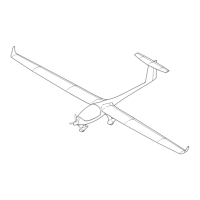FLIGHT MANUAL TSA-M, VARIANT S6
Doc.-No.:P400-006.000 E Page: 4-33 Revision: ---
Date of Issue: 07. October 2008 Agency approved Date of Rev.: --.--.----
Flying at high altitude can cause ice to form on the airframe. This can cause
significant disadvantages in the aerodynamic behavior, aircraft mass and CG-
position. A considerable decline of flight performance and behavior is possible.
Flights in icing-conditions are not allowed and must be avoided.
4.7.8 Flights in Rain
Rain influences the air-flow around the A/C. Flight performance and behavior
will change. When flying in rain, the following is recommended:
1.
Increase all recommended speeds for take-off and landing by at least
+ 6kts / 10 km/h. This should also be done for all other minimum air-
2. The climb-rate will decrease (up to 50%) and the cruise-speed will
decrease (up to 30%). These reductions have to be taken into account
when flight-planning. Also take into account the decreases in maximum
3. For flying in rain, no important changes of trim have been observed.
However, changes in the trim-speed should be expected.
4.7.9 Take-Off and Landing with Crosswind
For stronger crosswind the following is recommended:
1.
Take-off with FLAPS set to NEUTRAL. The A/C has no tendency to lift-
off automatically and should intentionally be rotated at 49 kts / 90 km/h
by PULLING slowly at the control-stick. The landing-gear’s
directional-stability reduces the A/C’s sensitivity to crosswind until
Note: The stall-speed with flaps set to NEUTRAL is 3 kts / 6 km/h
higher than with flaps set to TO / LDG 1.

